William Beanes
| William Beanes | |
|---|---|

"By Dawn's Early Light" 1912 painting by Edward Moran depicts the moment of the morning of September 14, 1814. Francis Scott Key with his compatriots Colonel John Skinner and Dr. William Beanes spy the American flag waving above Baltimore's Fort Mc Henry. This inspired Key to write the work to become the American national anthem, "The Star-Spangled Banner".
|
|
| Born |
January 24, 1749 Prince George's County, Province of Maryland, British America |
| Died | October 12, 1828 (age 79) Upper Marlboro, Maryland, U.S. |
| Nationality | American |
| Occupation | Physician |
| Parent(s) | William Beanes Mary Bradley |
William Beanes (January 24, 1749 – October 12, 1828) was an American physician during the U.S. colonial period.
Beanes was the third generation of the same name and the fourth generation American. He was born near Croome in Prince George's County, Maryland. Little is known of his childhood except that he is of Scottish descent. Throughout his life he spoke with a Scottish accent.
His parents were wealthy and owned large parcels of land in Prince George's County. Because of this Beanes grew up in a rural environment that was comfortable. Beanes may have been tutored for his basic education or otherwise graduated from a public school. It is known that he obtained initial medical education from one of the experienced medical practitioners in his town where he lived since there was no medical college in America at this time. Beanes began to practice medicine when he felt he was educated enough and qualified to do so.
Beanes married Sarah Hawkins Hanson on November 25, 1773. She was the niece of John Hanson, (1721-1783), later of Frederick, Maryland, who became the first president of the Confederation Congress of the United States (under the "Articles of Confederation and Perpetual Union"), proposed 1777, negotiated throughout the American Revolutionary War, and finally adopted in 1781 after delays caused mainly by Maryland (held in effect until March 1789 when the new Congress of the United States began to assemble under the newly approved and ratified throughout 1788-1789, of the Constitution of September 17, 1787, and carried through with the inauguration of George Washington as first president on April 30, 1789) after acceding to the demand by Maryland that several of the original thirteen states give up and cede their western land claims beyond the Appalachian Mountains to the joint control of the Cngress and the new Nation. In this annually elected office by the members of the Confederation Congress (with one house and one vote per state cast by delegates), he held the title of "President of the United States in Congress Assembled" (a title and reference used throughout that first "constitution" and loose system of government as "In Congress Assembled" as symbolizing desiring unity in most decisions made by the Confederation and weak central government) and some say technically then that he was the first "President of the United States".
...
Wikipedia
